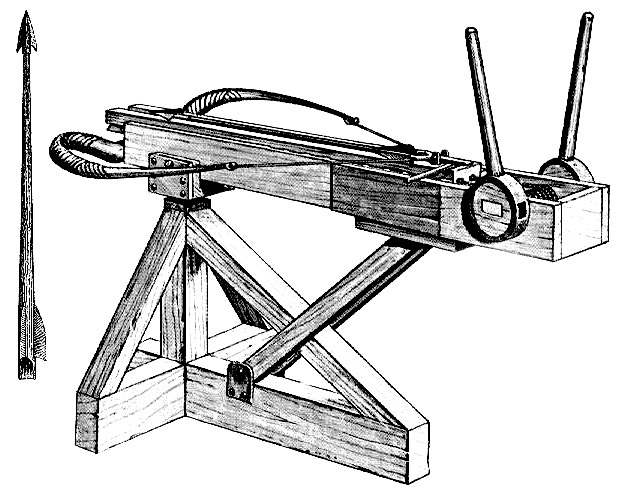|
Oxybeles
The oxybeles ( el, οξυβελής) was a weapon used by the Ancient Greeks starting in 375 BC. The word is derived from Ancient Greek: οξύς (''oxys'' = sharp, pointed) and βέλος (''belos'' = arrow). The weapon was basically an oversized gastraphetes, a composite bow placed on a stand with a stock and a trigger. It was supplanted by the scientifically engineered ballista The ballista (Latin, from Greek βαλλίστρα ''ballistra'' and that from βάλλω ''ballō'', "throw"), plural ballistae, sometimes called bolt thrower, was an ancient missile weapon that launched either bolts or stones at a distant .... The difference between the two is the use of torsion power by the ballista. The most notable use of the oxybeles was under Alexander the Great's rule. Notes Ancient Greek military terminology Ancient Greek artillery {{artillery-stub ... [...More Info...] [...Related Items...] OR: [Wikipedia] [Google] [Baidu] |
Ancient Greece
Ancient Greece ( el, Ἑλλάς, Hellás) was a northeastern Mediterranean Sea, Mediterranean civilization, existing from the Greek Dark Ages of the 12th–9th centuries BC to the end of Classical Antiquity, classical antiquity ( AD 600), that comprised a loose collection of culturally and linguistically related polis, city-states and other territories. Most of these regions were officially unified only once, for 13 years, under Alexander the Great's Macedonian empire, empire from 336 to 323 BC (though this excludes a number of Greek city-states free from Alexander's jurisdiction in the western Mediterranean, around the Black Sea, Cyprus, and Cyrenaica). In Western history, the era of classical antiquity was immediately followed by the Early Middle Ages and the Byzantine period. Roughly three centuries after the Late Bronze Age collapse of Mycenaean Greece, Greek urban poleis began to form in the 8th century BC, ushering in the Archaic Greece, Archaic period and Greek colonis ... [...More Info...] [...Related Items...] OR: [Wikipedia] [Google] [Baidu] |
Gastraphetes
The gastraphetes ( grc, γαστραφέτης, , belly-releaser), also called belly bow or belly shooter, was a hand-held crossbow used by the Ancient Greeks. It was described in the 1st century AD by the Greek author Heron of Alexandria in his work ''Belopoeica'', which draws on an earlier account of the famous Greek engineer Ctesibius (fl. 285–222 BC). Heron identifies the gastraphetes as the forerunner of the later catapult, which places its invention some unknown time prior to c. 420 BC. Unlike later Roman and medieval crossbows, spanning the weapon was not done by pulling up the string, but by pushing down an elaborate slider mechanism. Description A fairly detailed description and drawing of the gastraphetes appears in Heron's ''Belopoeica'' (Ancient Greek Βελοποιικά, English translation: ''On arrow-making''), drawn from the account by the 3rd-century BC engineer Ctesibius. The weapon was powered by a composite bow. It was cocked by resting the stomach in ... [...More Info...] [...Related Items...] OR: [Wikipedia] [Google] [Baidu] |
Ballista
The ballista (Latin, from Greek βαλλίστρα ''ballistra'' and that from βάλλω ''ballō'', "throw"), plural ballistae, sometimes called bolt thrower, was an ancient missile weapon that launched either bolts or stones at a distant target. Developed from earlier Greek weapons, it relied upon different mechanics, using two levers with torsion springs instead of a tension prod (the bow part of a modern crossbow). The springs consisted of several loops of twisted skeins. Early versions projected heavy darts or spherical stone projectiles of various sizes for siege warfare. It developed into a smaller precision weapon, the '' scorpio'', and possibly the '' polybolos''. Greek weapon The early ballistae in Ancient Greece were developed from two weapons called oxybeles and gastraphetes. The gastraphetes ('belly-bow') was a handheld crossbow. It had a composite prod and was spanned by bracing the front end of the weapon against the ground while placing the end of a sli ... [...More Info...] [...Related Items...] OR: [Wikipedia] [Google] [Baidu] |
Alexander The Great
Alexander III of Macedon ( grc, Ἀλέξανδρος, Alexandros; 20/21 July 356 BC – 10/11 June 323 BC), commonly known as Alexander the Great, was a king of the ancient Greek kingdom of Macedon. He succeeded his father Philip II to the throne in 336 BC at the age of 20, and spent most of his ruling years conducting a lengthy military campaign throughout Western Asia and Egypt. By the age of thirty, he had created one of the largest empires in history, stretching from Greece to northwestern India. He was undefeated in battle and is widely considered to be one of history's greatest and most successful military commanders. Until the age of 16, Alexander was tutored by Aristotle. In 335 BC, shortly after his assumption of kingship over Macedon, he campaigned in the Balkans and reasserted control over Thrace and Illyria before marching on the city of Thebes, which was subsequently destroyed in battle. Alexander then led the League of Corinth, and used his authori ... [...More Info...] [...Related Items...] OR: [Wikipedia] [Google] [Baidu] |
Ancient Greek Military Terminology
Ancient history is a time period from the beginning of writing and recorded human history to as far as late antiquity. The span of recorded history is roughly 5,000 years, beginning with the Sumerian cuneiform script. Ancient history covers all continents inhabited by humans in the period 3000 BCAD 500. The three-age system periodizes ancient history into the Stone Age, the Bronze Age, and the Iron Age, with recorded history generally considered to begin with the Bronze Age. The start and end of the three ages varies between world regions. In many regions the Bronze Age is generally considered to begin a few centuries prior to 3000 BC, while the end of the Iron Age varies from the early first millennium BC in some regions to the late first millennium AD in others. During the time period of ancient history, the world population was already exponentially increasing due to the Neolithic Revolution, which was in full progress. While in 10,000 BC, the world population stood a ... [...More Info...] [...Related Items...] OR: [Wikipedia] [Google] [Baidu] |

.jpg)

